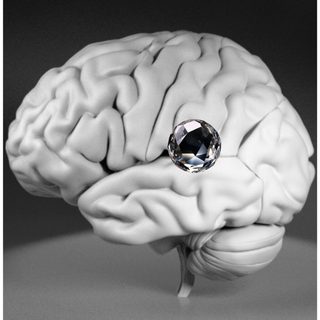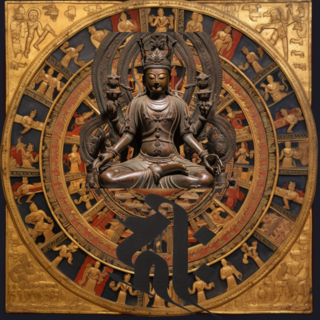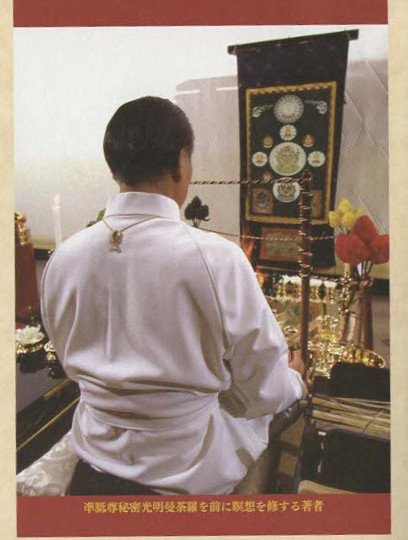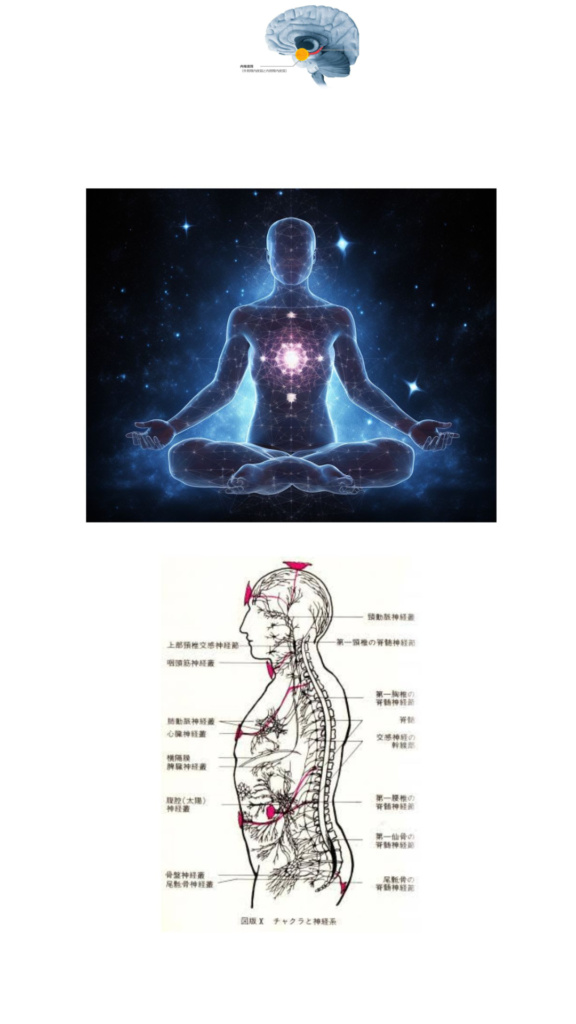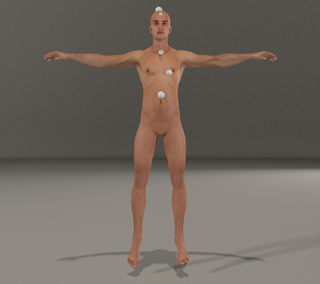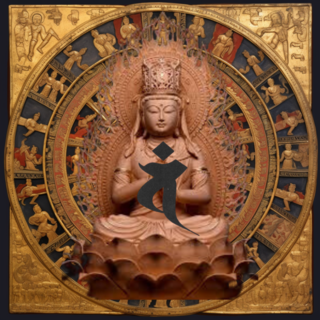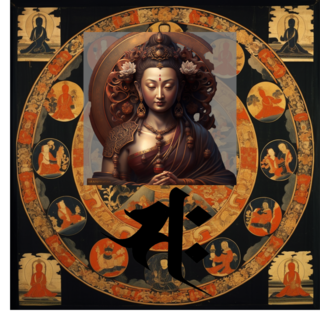求闘持聡明法一一一変身のカリキュラム
求聞持聡明法秘伝
チャクラを開発する三つの武器
求聞持聡明法による超能力開発は、ひと口にいうと、これまでくり返してのべてきたように、チャクラを開発して、そこから生ずる超人的子不ルギーを体の要所に送りこみ、それによって超人的な体力、超人的な精神力を獲得し、いごに、総合的な千不ルギーを脳に送って脳細胞を改造し、天才的な頭脳に変えてしまうというものである。
では、いったい、人間の持つ何かそういう力を発揮するのであろうか?
次の三つの武器を使うのである。
―、意 念
2、呼 吸
3、筋 肉
である。
この三つを武器にして、チャクラを覚醒させ、また、チャクラェルギーを体の各所に送りこむのである。
だが 、考えてみると、呼吸も、筋肉も、結局は、意念にょって操作されるものである。(潜在意識・深層意識をふくめこしたがって、究極的には、こころが主体となるわけである。
じっさい、その通りであって、チャクラを開発するのも、チャクラにおいて発生させた超人的子ェルギーを体の要点・要所に送りこみ、これを活動させるのも、すべてその原動力は、。こころ”なのである。こころがすべてなのだ。
こころとは、じつに偉大な力を持っているものなのである。
だがそういうと、いったい心なんていうものにそんな力があるのだろうかと疑う人がいるかも知れない。それももっともなことと思われるが、しかし、人間の心というものはじつに不思議な力を持っているのである。
意念むが持つ不思議な力
多くの人びとは気がついていないが、適切な方法をもって訓練すると、人間の心は信じられないような不思議な力を発揮する。その例はいくらでもあげることが出来る。たとえば、『スーパーネイチュアLの著者、L・ワトスンは、
つぎのように述べている。
-もう一つの実用的なチペットの風習はツモである。この技能は風邪をひかないためのもので、大部分の上地が標高一万フィート以上の国では、非常に尊重される能力である。入門者はまず、呼吸と瞑想を組合わせた方法を学び、遠く人里離れた土地へ行って修行する。
毎日、氷のはった渓流で水浴し、体内に燃える火を想像しながら雪の土にはだかで座る。修行が完了すると、風の吹く冬の夜に試験が行われる。入門者は布にくるまれ、渓流にはった氷に穴をあけて、そこにつけられるのであるが、体温でその布を少なくともその夜の間に三回、完全に乾かさなければならない。この試験に合格すると、修行者は、四季を通じて、どんな高所でも、単衣の木綿の衣服しか身にまとわないようになる。いくつかのエベレスト登山隊は、万年雪におおわれた山地で、完全にはだかの隠者がちゃんと生活しているのを見たとさえ報告している。
密教には、もっともっと高度の、人間を変えてしまう秘法がいくつもある。
しかし、その原理は一つである。心を使うのである。ただ、その使い方が問題である。L・ワトスンは、いともかんたんに、「体内に燃える火を想像しながら」と書いているが、それはそう単純なものではない。その修行者は、法に従って、深く微妙な心の使い方をしているのである。そしてまた、この修行は、
単に寒さにたえる能力だけを修行者にあたえるのではなく、寒さにたえる力は表面にあらわれただけのものであって、内面においてかれはもっともっと価値あるものを得ているはずなのである。そのことは、あなたも、これからしだいに理解されるようになるであろう。
ところで、その「心」を、わたくしは、そのはたらきの上から、つぎのよう
に分類している。
心・念・気
である。
意とは、意志、というように、心が一定の方向に向かって動いている状態を
さす。
念とは、意の動きが集中し高まって、ひとつの力を持つにいたった状態で、念力、という名がこれをよく表現している。
気とは、念が或る方向に向かって身体の中を流れて行く状態である。ただし、この「気」には、意識的につくり出されたものと、無意識的・生理的に、自然に身体の中を流れているものと、二種類ある。たとえば、「元気だ」というような言葉で表現されるものである。そこで、見かたによっては、気を集中したものが念なのだ、ということも出来るであろう。もともと、心という一つのものを分けて考えているのであるから、そこのところはどうともいえるわけである。ここでは、便宜上このように分類して、「気」という場合は主として意識的につくり出されたものをいっていると考えていただきたい。
養…………ヽむをどのように使うのか?
さて、それでは、その「心」をいったいどのように使うのであろうか?
心とは元来、この上なくとらえ難いものである。コロコロと常に動いてとどまらぬところから、これを約めてこころということになったのだといわれる位、
それは把握し難いものである。いったいどうやってこれを思う通りに駆使するのか?
一つ、方法があるのである。
なにか?
呼吸である。
心と呼吸とは、非常に密接な関係がある。
心の状態がそのまま呼吸にあらわれ、呼吸の状態がそのまま心を映し出す。
心が静まれば、呼吸も静まり、呼吸を静めれば心も静まる。心と呼吸は一体なのだ。
そこでI-、呼吸をコントロールすることにより、心をコントロールするという、高度のテクニックを使うのである。ここからスタートして、しだいに熟達し、ついには自分の思うように心を使うことができるようになるのである。
いや、それだけではない。一歩すすんで、体(筋肉)をも、思う通りに使いこなすことができるようになるのである。というのは、呼吸は心と一体であるが、それだけではなく、体とも一体であるからだ。修行が進むと、今度は、呼吸と心が一体になって、心がえがくイメージ通り、不随意筋をも動かすようになるのである。
Curriculum of transformation
Gumonji Satoshi Hou Hidden
Three weapons to develop chakras
In a nutshell, the development of psychic powers by the Gumonji Satoshi method develops chakras and sends the resulting superhuman childhood irritability to key points of the body, as we have repeatedly mentioned. By doing so, it acquires superhuman physical strength and superhuman mental power, and in the meantime, it sends a comprehensive thousand chakras to the brain to remodel brain cells and turn them into genius brains. ..
Then, does it exert any kind of human power?
Use the following three weapons.
-, Intention
2, call sucking
3, muscle meat
It is.
Using these three weapons, awaken the chakras and also the chakra child irrugies
It is sent to various parts of the body.
However, when you think about it, breathing and muscles are, after all, manipulated by will. (Including the subconscious and deep consciousness, therefore, ultimately, the mind becomes the subject.
That's right, the driving force is to develop the chakras, to send the superhuman child energy generated in the chakras to the main points and key points of the body, and to activate them. "Kokoro". Kokoro is everything.
The heart is the one that has great power.
However, there may be some who wonder if the mind has such power. That seems reasonable, but the human mind has a mysterious power.
The mysterious power of will
Many people are unaware, but when trained in an appropriate way, the human mind exerts an incredible and mysterious power. You can give as many examples as you like. For example, "The author of Super Nature L, L. Watson,
It states as follows.
-Another practical tippet custom is Tsumo. This skill is to avoid catching colds and is a highly respected ability in most countries where the land is above 10,000 feet above sea level. Beginners first learn how to combine breathing and meditation, and then go to remote areas to practice.
Every day, I bathe in an icy mountain stream and sit naked in the snow, imagining the fire burning inside my body. Once the training is complete, the test will take place on a windy winter night. Beginners are wrapped in a cloth, pierced with ice in a mountain stream, and put on it, but at body temperature the cloth must be completely dried at least three times during the night. After passing this exam, the practitioner will only wear a single cotton garment at any height throughout the four seasons. Some Everest climbers have even reported seeing a completely naked hermit living in a snow-capped mountain range.
Esoteric Buddhism has a number of more advanced and human-changing secrets.
However, the principle is one. Use your heart. However, how to use it is a problem. L. Watson simply wrote, "Imagine a fire burning in your body," but it's not that simple. The practitioner uses the deep and delicate mind according to the law. And again, this training is
Rather than simply giving the practitioner the ability to withstand the cold, the ability to withstand the cold is only manifested on the surface, and he must have gained much more value on the inside. That will be understood by you as well.
By the way, from the top of its function, I would like to express that "heart" as follows.
It is classified into.
Mind, mind, and qi
It is.
The will is the state in which the mind is moving in a certain direction, such as the will.
As expected.
Psychokinesis is a state in which the movements of mind are concentrated and heightened to have one power, and the name psychokinesis often expresses this.
Qi is a state in which the mind flows through the body in a certain direction. However, there are two types of "ki", one that is created consciously and the other that flows naturally in the body unconsciously and physiologically. For example, it is expressed by words such as "I'm fine." Therefore, depending on how you look at it, you may be able to say that you should focus on what you are looking for. Originally, one thing called the mind is considered separately, so that can be said to be insignificant. Here, for convenience, we classify them in this way, and when we say "ki", we would like you to think of it as something that was mainly consciously created.
Nourishment ………… How do you use ヽ?
Then, how do you use that "heart"?
The mind is, by nature, the most elusive. It is said that it was decided to reduce this from the place where it always moves and does not stop.
It's hard to grasp. How do you make full use of this as you wish?
There is one way.
Something?
Breathing.
The mind and breathing are very closely related.
The state of mind appears in breathing as it is, and the state of breathing reflects the mind as it is.
If the mind calms down, the breathing calms down, and if the breathing calms down, the mind calms down. The mind and breath are one.
Therefore, I-, an advanced technique of controlling the mind by controlling breathing is used. Starting from here, you will gradually become proficient and eventually you will be able to use your mind as you wish.
No, that's not all. You will be able to take a step forward and use your body (muscles) as you wish. Because breathing is one with the mind, but not only with the body. As the training progresses, the breathing and the mind become one, and the involuntary muscles move as the image of the mind evokes.
【このカテゴリーの最新記事】
-
no image
-
no image
-
no image
-
no image
-
no image

